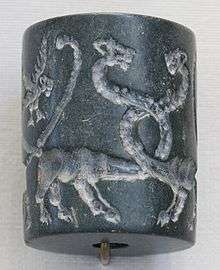Amorite language
| Amorite | |
|---|---|
| Native to | ancient Mesopotamia, by the Amorites |
| Extinct | 2nd millennium BC |
| Language codes | |
| ISO 639-3 |
None (mis) |
| Glottolog |
amor1239[1] |
Amorite is an early Northwest Semitic language, spoken by the Amorite tribes prominent in ancient Near Eastern history. It is known exclusively from non-Akkadian proper names recorded by Akkadian scribes during periods of Amorite rule in Babylonia (the end of the 3rd and the beginning of the 2nd millennium), notably from Mari, and to a lesser extent Alalakh, Tell Harmal, and Khafajah. Occasionally, such names are also found in early Egyptian texts; and one placename "Sənīr" (שְׂנִיר) for Mount Hermon, is known from the Bible (Deuteronomy 3:9). Notable characteristics include the following:
- The usual Northwest Semitic imperfective-perfective distinction is found: Yantin-Dagan, 'Dagon gives' (ntn); Raṣa-Dagan, 'Dagon was pleased' (rṣy). It included a 3rd-person suffix -a (unlike Akkadian or Hebrew), and an imperfect vowel, a-, as in Arabic rather than the Hebrew and Aramaic -i-.
- There was a verb form with a geminate second consonant — Yabanni-Il, 'God creates' (root bny).
- In several cases that Akkadian has š, Amorite, like Hebrew and Arabic, has h, thus hu 'his', -haa 'her', causative h- or ʼ- (I. Gelb 1958).
- The 1st-person perfect is in -ti (singular), -nu (plural), as in the Canaanite languages.
Notes
- ↑ Hammarström, Harald; Forkel, Robert; Haspelmath, Martin; Bank, Sebastian, eds. (2016). "Amorite". Glottolog 2.7. Jena: Max Planck Institute for the Science of Human History.
References
- D. Cohen, Les langues chamito-semitiques, CNRS: Paris 1985.
- I. Gelb, "La lingua degli amoriti", Academia Nazionale dei Lincei. Rendiconti 1958, no. 8, 13, pp. 143–163.
- H. B. Huffmon. Amorite Personal Names in the Mari Texts. A Structural and Lexical Study, Baltimore 1965.
- Remo Mugnaioni. "Notes pour servir d’approche à l’amorrite" Travaux 16 – La sémitologie aujourd’hui, Cercle de Linguistique d’Aix-en-Provence, Centre des sciences du language, Aix-en-Provence 2000, p. 57-65.
- M. P. Streck, Das amurritische Onomastikon der altbabylonischen Zeit. Band 1: Die Amurriter, Die onomastische Forschung, Orthographie und Phonologie, Nominalmorphologie. Alter Orient und Altes Testament Band 271/1, Münster 2000.
This article is issued from Wikipedia - version of the 8/23/2016. The text is available under the Creative Commons Attribution/Share Alike but additional terms may apply for the media files.
